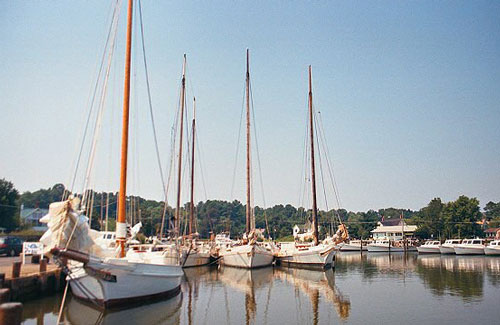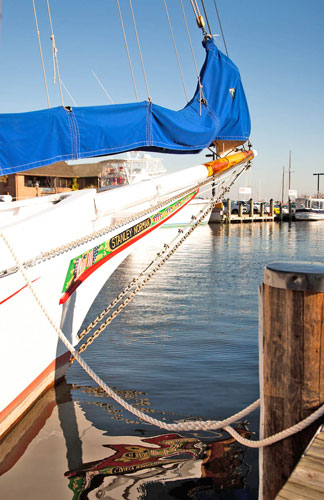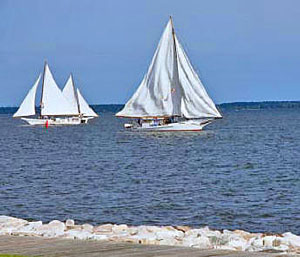Chesapeake Bay Skipjacks
The Chesapeake Bay skipjack fleet is the last commercial sailing powered fishing fleet in North America. Many of the remaining ships are in poor condition and the decline in oyster harvests has left their captains with little profit to maintain their vessels.
Soon after its introduction to the Chesapeake in the 1890s, the skipjack became the preferred oyster dredge boat. Some have estimated nearly two thousand skipjacks were built, all specifically designed for dredging oysters from the Chesapeake Bay. The peak building years were during the 1890s and the first decade of the 20th century.
Oystermen needed a light, inexpensive boat that was easy to construct and could navigate the shallower waters of the Bay. The skipjack’s wide beam, hard chine, and low freeboard provided a stable, large working and storage platform. The single-masted rig, with sharp-headed mainsail and large jib, was easy to handle, powerful in light winds, and capable of coming about quickly without losing way. All these traits made the skipjack ideally suited to performing continuous “licks” (passes) over the oyster beds. The skipjack was also so simple to build that even house carpenters could construct one. As a result, hundreds of skipjacks were built when they first came on the scene in the 1890s and during their heyday there were as many as two thousand skipjacks on the Bay.
Significant decline in oyster prices in the early 1900s resulted in the abandonment and destruction of much of the skipjack fleet. Oyster prices increased somewhat after WWII, leading to the construction of a few new skipjacks. At that point the size of the fleet climbed into the 70s. The skipjack fleet, however, has declined slowly ever since then.

Today, there are only about 30 skipjacks left, and many of those are in such poor condition that it is unlikely that they can be rejuvenated. A few of the originals, however, have been lovingly restored, and some of thee newer vessels that have been kept in good repair.
Some of the restored vessels are on display at museums, while others are used for educational purposes. And there are a few skipjacks left that still ply the trade they were originally built for, dredging for oysters on the Chesapeake Bay.
In the year 2000, the State of Maryland made a commitment to preserving and restoring the Chesapeake Bay skipjack fleet. The first step taken by the state was to designate the skipjack as the official state boat, because of its historic and economic importance and its symbolic value as a representation of the people of Maryland and their lifestyle. Second, the state formed a task force to address some of the obstacles that have led to the decline of the fleet. One recommendation which emerged was to provide subsidized repair services to the active dredge vessels to stabilize their condition while the oyster stocks were being replenished. The Chesapeake Bay Maritime Museum has provided the use of its boat shop facility, marine railway, and skilled staff for fleet repair.
With funding from The Maryland Historic Trust, the National Trust for Historic Preservation, and numerous private businesses, the skipjack restoration project began in July of 2001. Under the direction of a the Chesapeake Bay Maritime Museum’s master shipwright, a crew of boat carpenter apprentices are providing the skilled labor needed to accomplish the task. Chesapeake Bay wood boatbuilding techniques are being handed down to the next generation and skipjacks are being preserved for generations to come. Since the program’s inception, nine skipjacks have received repair services from the restoration project.
“Skipjack”
The name “skipjack” is said to have been derived from fish, such as the skipjack mackerel or skipjack tuna, that jump in and out of the water because these boats can sometimes resemble the fish as they come about quickly making continuous passes or “licks” over oyster beds. Another possible origin of the name is an archaic English word meaning “inexpensive yet useful servant”. The typical cost of a skipjack in 1905 was $3,000.
The Remaining Skipjacks
- Ada Fears. Ridge, MD. Built in Oxford, Maryland in 1968.
- Caleb W. Jones. Built in 1953.
- City of Crisfield. Deal Island, Maryland. Built in Reedville, Virginia in 1949.
- City of Norfolk. Norfolk, Virginia. Built in Deale, Maryland in 1900.
- Claud M. Somers. Reedville, VA. Built in Accomack County, VA in 1911.
- Dee of St. Mary’s. Calvert Marine Museum, Solomons, MD. Built in Piney Point, Maryland in 1979.
- E.C. Collier. St. Michaels, MD. Built in Deal Island in 1910.
- Elsworth. Worton, MD. Built in 1901.
- Fanny L. Daugherty. Deal Island, MD. Built in Crisfield, Maryland in 1904.
- F.C. Lewis, Jr. West Denton, MD.
- Helen Virginia. Built in Crisfield, Maryland in 1948.
- Hilda M. Willing. Tilghman Island, Maryland. Built in Oriole, Maryland in 1905.
- H.M. Krentz. Tilghman Island, MD. Built in Harryhogan, Virginia in 1955.
- Ida May. Deal Island, MD. Built in Urbanna, Virginia in 1906.
- Joy Parks. St. Mary’s County Piney Point Museum. Built in 1936 in Parksley, Virginia.
- Kathryn. Tilghman Island, Maryland. Built in Crisfield, Maryland in 1901.
- Lady Katie. Cambridge, MD. Built in Wingate, Maryland in 1956.
- Mamie A. Mister. Tilghman Island, MD. Built in Deal Island, Maryland in 1911.
- Martha Lewis. Havre de Grace, MD. Built in Wingate, Maryland in 1955.
- Minnie V. Baltimore, MD. Built in Wenonah, Maryland in 1906.
- Nathan. Cambridge, MD. Built Cambridge, Maryland in 1992.
- Nellie L. Byrd. Tilghman Island, MD. Built in Oriole, Maryland in 1911.
- Rebecca T. Ruark. Tilghman Island, MD. Built in Taylors Island, Maryland in 1886.
- Rosie Parks. St. Michaels, MD. Built in Wingate, Maryland in 1955.
- Sigsbee. Baltimore, MD. Built in Oriole, Maryland in 1901.
- Somerset. Deal Island, MD. Built in Reedville, Virginia in 1949.
- Stanley Norman. Annapolis, MD. Built in 1902.
- Thomas Clyde. Tilghman Island, MD. Built in Oriole, MD in 1911.
- Virginia W. Port Kinsale, VA. Built in Guilford, Virginia in 1904.
- Wilma Lee. Kinsale, VA. Built in Wingate, MD in 1940.
Go For a Sail
Several of the Chesapeake Bay skipjacks offer public cruises. A trip on an authentic Chesapeake Bay skipjack offers a rare opportunity to experience first hand a piece of Chesapeake Bay history.
- Skipjack Claud M. Somers. Owned and operated by the Reedville Fishermen’s Museum in Reedville, Virginia. Offers regular sails for museum members.
- Skipjack Dee of St. Mary’s. The Calvert Marine Museum in Solomons, Maryland, offers public sails.
- Skipjack Herman Krantz, Capt. Ed Farley Skipjack Cruises out of St. Michaels, Maryland. 410-745-6080
- Skipjack Martha Lewis. Owned and operated by the nonprofit organization, Chesapeake Heritage Conservancy. Offers public sails out of Havre de Grace, Maryland.
- Skipjack Stanley Norman. A Chesapeake Bay Foundation skipjack that offers public sails out of Annapolis.
- Skipjack Nathan of Dorchester. Skipjack built by volunteers in 1994. Offers public sails out of Cambridge, Maryland. Cruise on the scenic Choptank River, help raise her sails or take a turn at the helm, and hear stories of the working watermen.
- Skipjack Rebecca T. Ruark. Hands-on sailing experience onboard the oldest working skipjack. Learn Chesapeake ecology, maritime history, and oyster-dredge demonstration. USCG certified 49 passengers. Walk-ons, buses, families, weddings, sunsets. Capt. Wade H. Murphy. SkipJack Cruises out of Tilghman Island, Maryland.
Skipjack Resources
- Crockett’s Gallery – Screensaver size images of skipjacks in the Deal Island Skipjack Races.
- Skipjack Sunday – A collection on recently discovered photographs taken at Deal Island in 1967.
- Skipjacks dredge up nautical heritage for guests. A Chesapeake Bay Journal article about Skipjacks and excursions.





